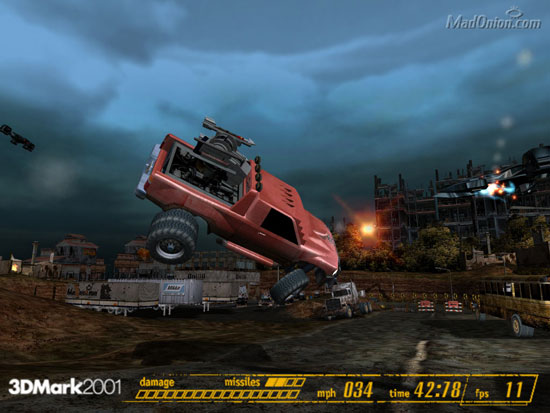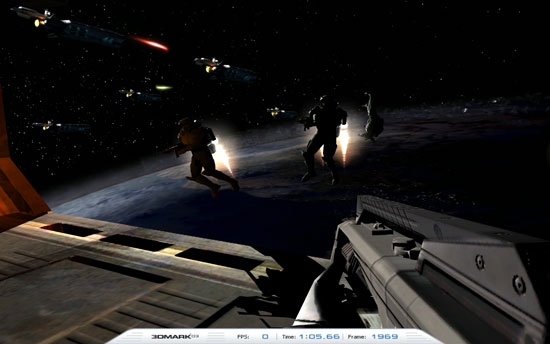Futuremark: of Benchmarks and Gaming
by Jarred Walton on January 30, 2008 2:00 AM EST- Posted in
- Software
Introduction
One of the most controversial subjects when it comes to benchmarking graphics performance is undoubtedly Futuremark — specifically their "gaming" benchmarks, the 3DMark series. For 10 years now, we have seen graphics card reviews bicker and argue about the viability of using 3DMark. On the one hand, we have those who insist the 3DMark tools are nothing more than a synthetic graphics benchmark, encouraging heavy optimizations from the various GPU companies in order to come out on top. The other side of the equation consists of people looking for an easy way to categorize performance, plus a group of diehard benchmarkers who are in constant competition to come out on top of the ORB (Online Results Browser) charts. As with so many things in life, reality strikes more of a middle ground.
While there are occasions where the performance metrics generated by the Futuremark tools correlate well to certain real-world games, very few people are going to be interested in purchasing hardware based solely on 3DMark performance. On the other hand, there have been many occasions throughout the history of PC gaming where users have upgraded hardware purely to improve performance in the latest and greatest game. GL-Quake helped to sell thousands (millions even?) of 3dfx graphics cards, which in turn helped to kick-start our modern obsession with 3D gaming.
 |
 |
Take a look at the images in this article for a moment; certainly we're not the only people in the world who when first greeted by a new 3DMark have thought, "Daaaaamn! That is a sweet looking benchmark and it would make an awesome game. They should turn that concept into a real game rather than a 60 second benchmark scene." If you're with us on this one, the wait may be over... sort of.
It appears that Futuremark has been secretly hard at work on their first full retail game, and while we don't have any details on what sort of game it will be or when it will launch, they have announced the formation of Futuremark Games Studio. The plans sound ambitious, with the following statement: "For years, our fans have been asking us when we will start making games. Very soon they are going to get it - and then some!" If we're lucky, we may end up with not just one title but numerous cutting edge titles over the coming years.
That's the core of the announcement, but let's take a minute to discuss exactly why we think this is at all meaningful.










18 Comments
View All Comments
perzy - Wednesday, January 30, 2008 - link
A question for Anandtech:Why dont you say the truth: ATI/AMD cards s**k at OpenGL compared to Nvidia. ATI/AMD has an edge in DirectX instead.
It not just speed but IQ also in OpenGL.
I have found out this the hard way, through my wallet(had to buy a nvidia card because my ATIcard was so bad in UT99) and no thanks to any hardware site.
Are you so firmly corrupted that you cant print that?
Honestly I dont understand. I'm probably an idiot.
MrKaz - Wednesday, January 30, 2008 - link
Living in a rock lately?The ATI/AMD has now surpassed the Nvidia team in OpenGL.
Some thought would be impossible.
http://www.3dprofessor.org/Current%20Reviews.htm">http://www.3dprofessor.org/Current%20Reviews.htm
Also the ATI/AMD has made major steps in Linux that I have doubts that Nvidia is still the leader there too.
The problem is that websites like this one don’t update the tests/results, so everyone still thinks Nvidia is the ultimate king.
Hey AMD kicked Intel balls for 6 years and lots of people saw Intel products has the “better” during that time without any "knowledge".
I bet people like you still things ATI Opengl drivers still suck based on 1999 tests. Nice way to go out and live 2008.
greylica - Wednesday, January 30, 2008 - link
Open device drivers is the most important step to ensure a new openGL market will rise again. AMD still didn't give a totally free device driver, but the manual of certain cards to developers, as far as I know.I am waiting to see, but the results of the V8600 are impressive.
But the Consumer Radeon still s**ks a lot in OpenGL device drivers in Windows and in Linux. I am a Blender/Linux user.
Most of Nvidia cards ( even if it's not a quadro card ) is very good in OpenGL/Linux environment.
In the past I have problems with device drivers "optimized" for games in directX, and in the past there was an card that simply doesn't have the OpenGL client device drivers too.
On the other hand, the mayor problem of AMD/ATI is advertising here in Brazil. Intel is on some channels once a week. I ask:
Where is AMD products ?
Proteusza - Wednesday, January 30, 2008 - link
UT99? You mean 9 years ago, when 3D was still quite new? Um... Do you know how long 9 years is in computing? Please dont tell me you still dont buy ATI because of that!Also remember that, at the time, Glide was huge. So UT probably didnt run very well on anything except 3dfx cards. have a look at modern benchmarks with games like Quake IV and Doom 3. As far as I remember, there isnt much of a difference.
Another thing - how many modern games use OpenGL? I can only think of the 2 examples above.
teldar - Wednesday, January 30, 2008 - link
That and as far as IQ, is that supposed to mean AI? AI is based on other game code other than visual, and the GPU doesn't have anything to do with AI. That's all CPU based. So how is it AMD's fault if there was something wrong with the AI on your computer?T
chrnochime - Wednesday, January 30, 2008 - link
I think he meant I[/B}mage Q[/B}uality.crimson117 - Wednesday, January 30, 2008 - link
wonder if that will fix the bolding...
crimson117 - Wednesday, January 30, 2008 - link
maybe two will do it?